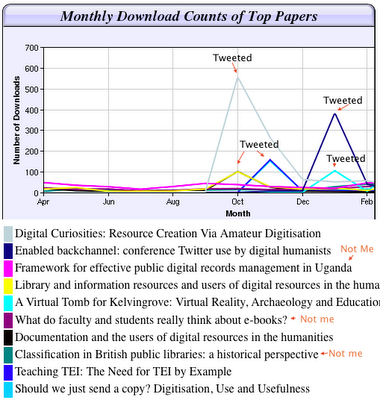Publishing in an Open Access Journal
Publishing in an Open Access Journal
3. High Impact Journals and Open Access Uptake
3.2. Social Media as a Tool for Increasing Citation Rates
One should not forget the power of social media tools today to help disseminate knowledge and information in such a speedy fashion.
Melissa Terras, the Co-Director of University College London Centre for Digital Humanities, has experimented with tweeting and blogging as a medium for disseminating information and gathering citation statistics on one of her Open Access articles. She charts her experiment in her paper ‘The Impact of Social Media on the Dissemination of Research: Results of an Experiment’. Her experiment shows, without any equivocation, that an Open Access paper which is also tweeted and blogged about gets much higher download and citation rates. The chart below represents what happened to her paper ‘Digital Curiosities: Resource Creation via Amateur Digitisation’:

This is the author's comments on what happened:
Prior to me blogging and tweeting about the paper, it was downloaded twice (not by me). The day I tweeted and blogged it, it immediately got 140 downloads. This was on a Friday; on the Saturday and Sunday it got downloaded, but by fewer people. On Monday it was retweeted and the paper received a further 140 or so downloads. I have no idea what happened on the 24th of October — someone must have linked to it? Posted it on a blog? Then there were a further 80 downloads. Then the traditional long tail, then it all goes quiet…All in all, it’s been downloaded 535 times since it went live, from all over the world...[Terras, M. 'The Impact of Social Media on the Dissemination of Research: Results of an Experiment’, The Journal of Digital Humanities, (1)3, 2012]
The author concludes that blogging and tweeting about research papers are worth it and advises researchers that, as well as making their papers Open Access, they should tweet and blog about their work. The chart below shows what happens to papers that are tweeted and blogged about as opposed to those which do not have that advantage:

According to the author, statistics show that the 'Digital Curiosities' article was the fifth most downloaded paper in the UCL repository in October 2011. Read about the full experiment here.
Gunther Eysenbach from the University of Toronto, Centre for Global eHealth Innovation also has carried out a research on social media as a tool for increasing citation rates. He has authored a work experimenting on Twitter as a medium for calculating impact factors for Open Access articles: 'Can Tweets Predict Citations? Metrics of Social Impact Based on Twitter and Correlation with Traditional Metrics of Scientific Impact'. For a given period of time, the author mined all tweets containing links to articles in the Open Access Journal of Medical Internet Research. He then calculated different metrics of social media impact and compared them against subsequent citation data from Scopus and Google Scholar. His experiment to predict the top-cited articles in each issue through tweet metrics was validated, and he concluded that,
Tweets can predict highly cited articles within the first 3 days of article publication. Social media activity either increases citations or reflects the underlying qualities of the article that also predict citations, but the true use of these metrics is to measure the distinct concept of social impact. Social impact measures based on tweets are proposed to complement traditional citation metrics. The proposed twimpact factor may be a useful and timely metric to measure uptake of research findings and to filter research findings resonating with the public in real time. [Eysenbach, G. ‘Can Tweets Predict Citations? Metrics of Social Impact Based on Twitter and Correlation with Traditional Metrics of Scientific Impact', Journal of Medical Internet Research, 13(4), December 2011]
The author uses terms ‘Tweetation’ for a citation in a tweet mentioning a journal article URL and ‘Twimpact’ for the cumulative number of tweetations 7 days after publication of the article in his paper. He counts ‘Tweetations’ to gather citation statistics for his own article. As of mid-March 2013, there have been 1175 citations since the paper's publication in December 2011 and the figure is rising. It is unlikely that a paper published in a journal which may have a high impact factor but is not Open Access could boast of similar citation rates. Read about the full experiment here.